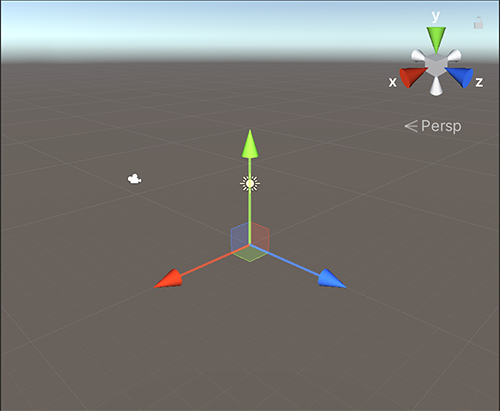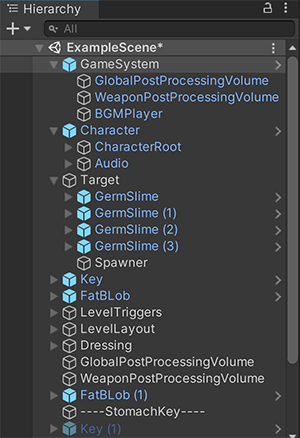Transform
The Transform stores a GameObject’s Position, Rotation, Scale and parenting state. A GameObject always has a Transform component attached: you can’t remove a Transform or create a GameObject without a Transform component.
Transform コンポーネント
The Transform component determines the Position, Rotation, and Scale of each GameObject in the scene. Every GameObject has a Transform.

Tip: You can change the colors of the Transform axes (and other UI elements) (Menu: Unity > Preferences and then select the Colors & keys panel).
プロパティ
| プロパティ | 機能 |
|---|---|
| Position | Position of the Transform in the x, y, and z coordinates. |
| Rotation | Rotation of the Transform around the x-axis, y-axis, and z-axis, measured in degrees. |
| Scale | Scale of the Transform along the x-axis, y-axis, and z-axis. The value “1” is the original size (the size at which you imported the GameObject). |
Unity measures the Position, Rotation and Scale values of a Transform relative to the Transform’s parent. If the Transform has no parent, Unity measures the properties in world space.
Transform の編集
In 2D space, you can manipulate Transforms on the x-axis or the y-axis only. In 3D space, you can manipulate Transforms on the x-axis, y-axis, and z-axis. In Unity, these axes are represented by the colors red, green, and blue respectively.

There are three primary ways you can edit a Transform’s properties:
- In the Scene view
- In the Inspector window
- In your C# scripts
Scene view
In the Scene view, you can use the Move, Rotate and Scale tools to modify Transforms. These tools are located in the upper left-hand corner of the Unity Editor.

You can use the Transform tools on any GameObject in a scene. When you select a GameObject, the tool Gizmo appears within it. The appearance of the Gizmo depends on which tool you select.

When you click and drag on one of the three Gizmo axes, the axis’s color changes to yellow. While you drag the mouse, the GameObject moves, rotates, or scales along the selected axis. When you release the mouse button, the axis remains selected
While moving the GameObject, you can lock movement to a particular plane (that is, change two of the axes and keep the third unchanged). To activate the lock for each plane, select the three small coloured squares around the center of the Move Gizmo. The colors correspond to the axis that locks when you select the square (for example, select the blue square to lock the z-axis).
Inspector window
In the Inspector window, you can use the Transform component to edit the Transform properties of a selected GameObject. There are two ways to edit the Transform property values in the component:
- Enter values into the property value fields manually. This is useful for very specific adjustments.
- Click a value field and drag up or down to increase or decrease the value. This is useful for less specific adjustments.
C# script
Use the Transform API to edit the Transform of a GameObject through script.
Grouping GameObjects
In Unity, you can group GameObjects into parent-child hierarchies: * A parent GameObject has other GameObjects connected to it that take on its Transform properties. * A child GameObject is connected to another GameObject, and takes on that GameObject’s Transform properties.
In the Hierarchy window, child GameObjects appear directly underneath parent GameObjects and are indented in the list. You can select the fold-out icon to hide or reveal a parent GameObject’s child GameObjects.
A child GameObject moves, rotates, and scales exactly as its parent does. Child GameObjects can also have child GameObjects of their own. A GameObject can have multiple child GameObjects, but only one parent GameObject.
These multiple levels of parent-child relationships between GameObjects form a Transform hierarchy. The GameObject at the top of a hierarchy (that is, the only GameObject in the hierarchy that doesn’t have a parent) is known as the root GameObject.
To create a parent GameObject, drag any GameObject in the Hierarchy window onto another. This creates a parent-child relationship between the two GameObjects.

Editing Transforms for parent and child GameObjects
You can group GameObjects into parent-child hierarchies. For more information, see [Grouping GameObjects](link to section on GameObject.html page).
The Transform values for any child GameObject are displayed relative to the parent GameObject’s Transform values. These values are called local coordinates. For scene construction, it is usually sufficient to work with local coordinates for child GameObjects. In gameplay, it is often useful to find their global coordinates or their exact position in world space. The scripting API for the Transform component has separate properties for local and global Position, Rotation and Scale, and lets you convert between local and global coordinates.
Tip: When you parent Transforms, it is useful to set the parent’s location to <0,0,0> before you add the child Transform. This means that the local coordinates for the child Transform will be the same as the global coordinates, which makes it easier to ensure the child Transform is in the right position.
Tranforms and Scale
The Scale of the Transform determines the difference between the size of a mesh in your modeling application and the size of that mesh in Unity. The mesh’s size in Unity (and therefore the Transform’s Scale) is important, especially during physics simulation. By default, the physics engine assumes that one unit in world space corresponds to one meter. If a GameObject is very large, it can appear to fall in “slow motion”; the simulation is correct because you are watching a very large GameObject fall a great distance.
Three factors affect the Scale of your GameObject:
- 3D モデリングアプリケーションでのメッシュのサイズ
- The Mesh Scale Factor setting in the GameObject’s Import Settings.
- Transform コンポーネントの Scale 値
Don’t adjust the Scale of your GameObject in the Transform component. If you create your models at real-life scale, you won’t have to change your Transform’s Scale. You can also adjust the scale at which your mesh is imported because some optimizations occur based on the import size. Do this in the Import settings for your individual mesh. Instantiating a GameObject that has an adjusted Scale value can decrease performance.
Note: Changing the Scale affects the position of child Transforms. For example, scaling the parent Transform to (0,0,0) positions all child Transforms at (0,0,0) relative to the parent Transform.
Non-uniform scaling
Non-uniform scaling is when the Scale in a Transform has different values for x, y, and z; for example (2, 4, 2). In contrast, uniform scaling has the same value for x, y, and z; for example (3, 3, 3). Non-uniform scaling can be useful in a few specific cases but it behaves differently to uniform scaling:
- Some components don’t fully support non-uniform scaling. For example, some components have a circular or spherical element defined by a Radius property, such as Sphere Collider, Capsule Collider, Light and Audio Source. This means the circular shape remains circular under non-uniform scaling instead of elliptical.
- If a child GameObject has a non-uniformly scaled parent GameObject and is rotated relative to that parent GameObject, it might appear skewed or “sheared”. There are components that support simple non-uniform scaling but that don’t work correctly when skewed like this. For example, a skewed Box Collider does not match the shape of the rendered mesh accurately.
- A child GameObject of a non-uniformly scaled parent GameObject does not have its scale automatically updated when it rotates. As a result, the child GameObject’s shape might appear to change abruptly when you eventually update the scale, for example, if the child GameObject is detached from the parent GameObject.
Transform